2016 MERCEDES-BENZ GL warning
[x] Cancel search: warningPage 74 of 462
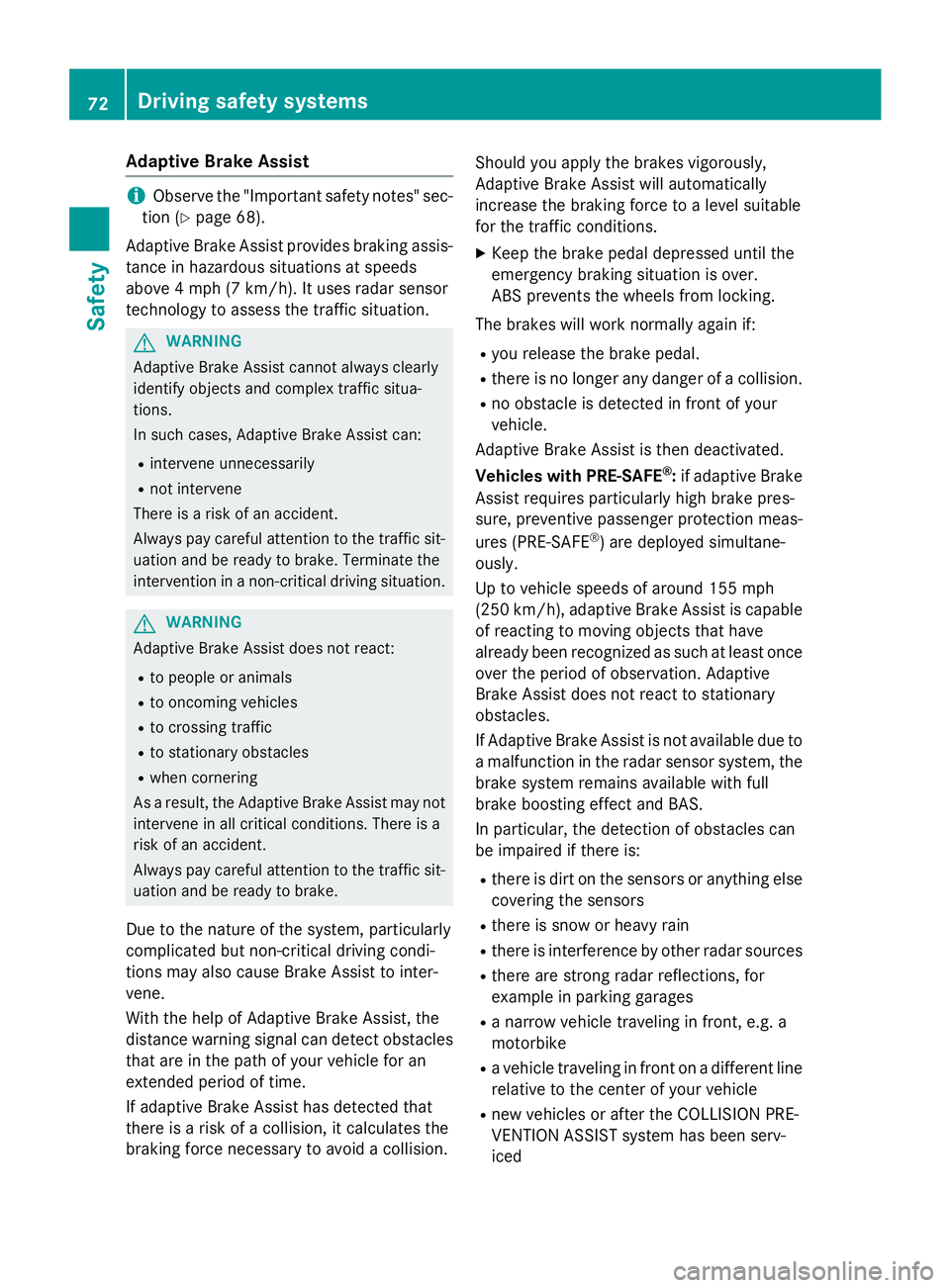
Adaptive Brake Assist
i Obs erv e th e "Importan t safet y notes" sec -
tion ( Y
page 68) .
Adaptive Brake Assis t provide s braking assis-
tance in hazardous situation s at speeds
abov e 4 mph (7 km/h). It uses radar sensor
technology to assess th e traffic situation .
G WARNIN G
Adaptive Brake Assis t canno t always clearly
identify objects and complex traffic situa-
tions.
In suc h cases, Adaptive Brake Assis t can :R
interven e unnecessarilyR
no t interven e
There is a ris k of an accident.
Always pay careful attention to th e traffic sit -
uation and be read y to brake. Terminate th e
intervention in a non-critical drivin g situation .
G WARNIN G
Adaptive Brake Assis t does no t react:R
to people or animals R
to oncomin g vehiclesR
to crossing traffic R
to stationary obstacles R
when cornering
As a result , th e Adaptive Brake Assis t may no t
interven e in all critical conditions. There is a
ris k of an accident.
Always pay careful attention to th e traffic sit -
uation and be read y to brake.
Due to th e nature of th e system, particularly
complicated but non-critical driving condi-
tion s may also caus e Brake Assis t to inter-
vene.
Wit h th e help of Adaptive Brake Assist, th e
distanc e warning signal can detec t obstacles
that are in th e pat h of your vehicl e for an
extended period of time.
If adaptive Brake Assis t has detecte d that
there is a ris k of a collision , it calculates th e
braking force necessar y to avoi d a collision . Should you apply th e brakes vigorously,
Adaptive Brake As sist will automatically
increas e th e braking force to a level suitable
for th e traffic conditions. X
Kee p th e brak e pedal depressed until th e
emergenc y braking situation is over.
AB S prevents th e wheels from locking .
The brakes will wor k normally again if: R
you release th e brak e pedal .R
there is no longer any danger of a collision .R
no obstacle is detecte d in fron t of your
vehicle.
Adaptive Brake As sist is then deactivated.
Vehicles wit h PRE-SAFE ®
: if adaptive Brake
Assis t require s particularly high brak e pre s-
sure, preventive passenger protection meas -
ures (PRE-SAF E ®
) are deployed sim ultane -
ously.
Up to vehicl e speeds of aroun d 15 5 mph
(25 0 km/h), adaptive Brake Assis t is capable
of reacting to moving objects that hav e
already been recognized as suc h at least once
ove r th e period of observation . Adaptive
Brake Assis t does no t reac t to st ationary
obstacles.
If Adaptive Brake As sist is no t available due to
a malfunction in th e radar sensor system, th e
brak e system remain s available wit h full
brak e boosting effec t and BAS.
In particular, th e detection of obstacles can
be impaire d if there is: R
there is dirt on th e sensors or anythin g else
covering th e sensors R
there is sn ow or heav y rainR
there is interferenc e by other radar source sR
there are st ron g radar reflections, for
exampl e in parking garages R
a narrow vehicl e traveling in front, e.g. a
motorbik e R
a vehicl e traveling in fron t on a differen t lin e
relative to th e center of your vehicl eR
ne w vehicles or after th e COLLISION PRE -
VE NTION ASSIST system has been ser v-
ice d72
Driving safety systems
Safety
Page 75 of 462
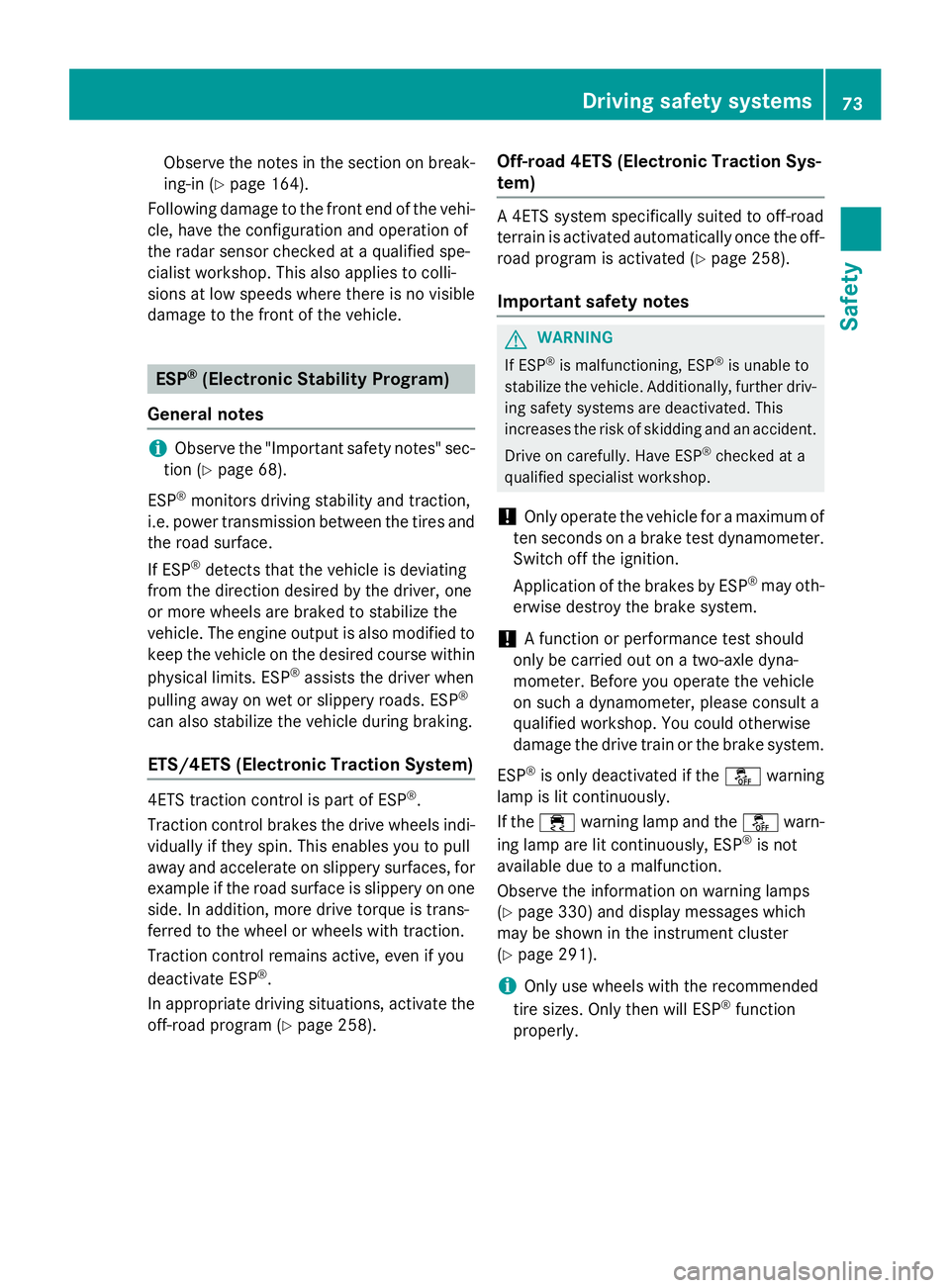
Observe the notes in the section on break-
ing-in ( Y
page 164).
Following damage to the front end of the vehi-
cle, have the configuration and operation of
the radar sensor checked at a qualified spe-
cialist workshop. This also applies to colli-
sions at low speeds where there is no visible
damage to the front of the vehicle.
ESP ®
(Electronic Stability Program)
General notes
i Observe the "Important safety notes" sec-
tion ( Y
page 68).
ESP ®
monitors driving stability and traction,
i.e. power transmission between the tires and
the road surface.
If ESP ®
detects that the vehicle is deviating
from the direction desired by the driver, one
or more wheels are braked to stabilize the
vehicle. The engine output is also modified to
keep the vehicle on the desired course within
physical limits. ESP ®
assists the driver when
pulling away on wet or slippery roads. ESP ®
can also stabilize the vehicle during braking.
ETS/4ETS (Electronic Traction System)
4ETS traction control is part of ESP ®
.
Traction control brakes the drive wheels indi-
vidually if they spin. This enables you to pull
away and accelerate on slippery surfaces, for
example if the road surface is slippery on one
side. In addition, more drive torque is trans-
ferred to the wheel or wheels with traction.
Traction control remains active, even if you
deactivate ESP ®
.
In appropriate driving situations, activate the
off-road program ( Y
page 258). Off-road 4ETS (Electronic Traction Sys-
tem) A 4ETS system specifically suited to off-road
terrain is activated automatically once the off-
road program is activated ( Y
page 258).
Important safety notes
G WARNING
If ESP ®
is malfunctioning, ESP ®
is unable to
stabilize the vehicle. Additionally, further driv-
ing safety systems are deactivated. This
increases the risk of skidding and an accident.
Drive on carefully. Have ESP ®
checked at a
qualified specialist workshop.
! Only operate the vehicle for a maximum of
ten seconds on a brake test dynamometer.
Switch off the ignition.
Application of the brakes by ESP ®
may oth-
erwise destroy the brake system.
! A function or performance test should
only be carried out on a two-axle dyna-
mometer. Before you operate the vehicle
on such a dynamometer, please consult a
qualified workshop. You could otherwise
damage the drive train or the brake system.
ESP ®
is only deactivated if the �
Page 77 of 462
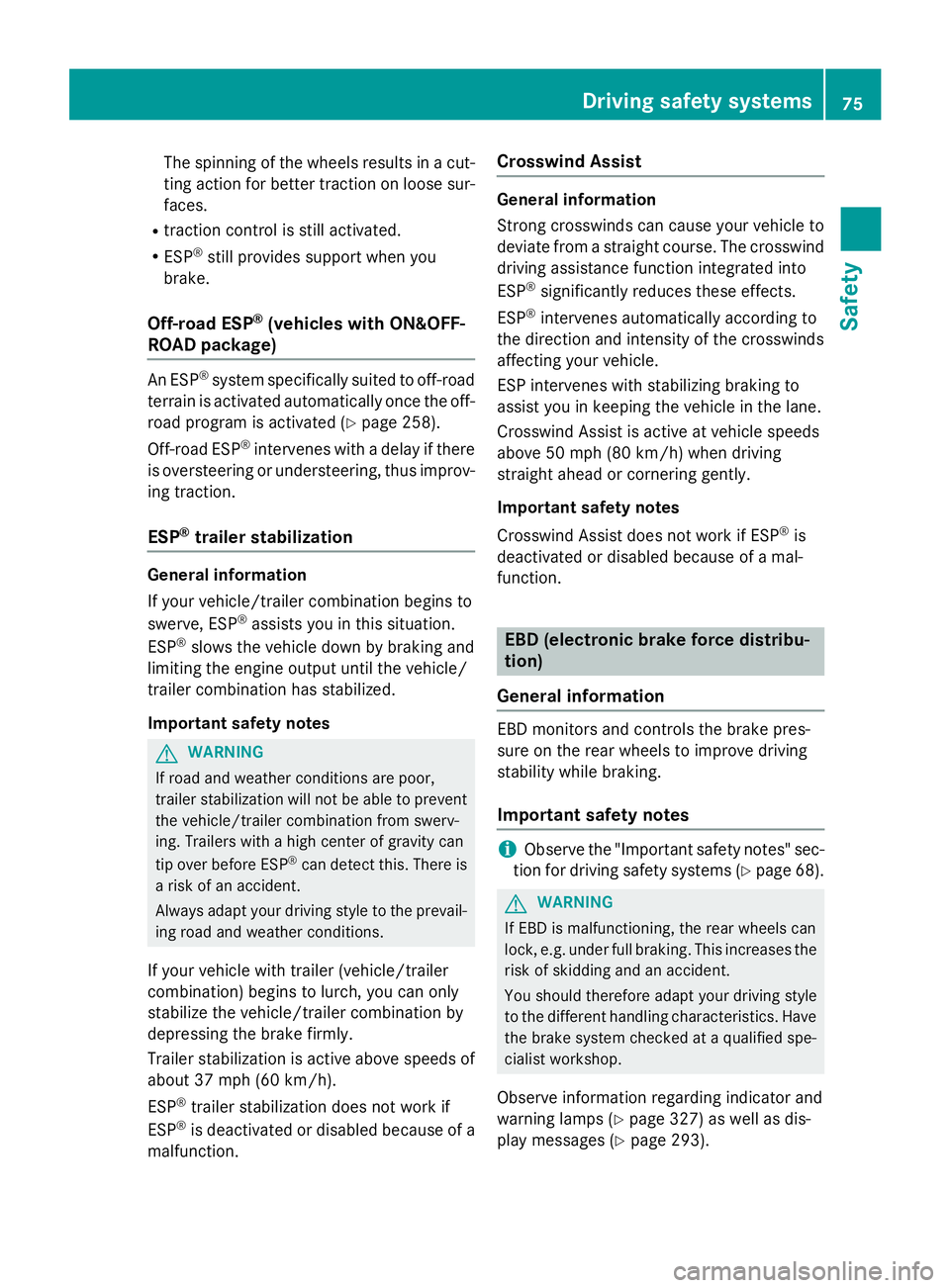
The spinning of the wheels results in a cut-
ting action for better traction on loose sur-
faces. R
traction control is still activated. R
ESP ®
still provides support when you
brake.
Off-road ESP ®
(vehicles with ON&OFF-
ROAD package) An ESP ®
system specifically suited to off-road
terrain is activated automatically once the off-
road program is activated ( Y
page 258).
Off-road ESP ®
intervenes with a delay if there
is oversteering or understeering, thus improv-
ing traction.
ESP ®
trailer stabilization
General information
If your vehicle/trailer combination begins to
swerve, ESP ®
assists you in this situation.
ESP ®
slows the vehicle down by braking and
limiting the engine output until the vehicle/
trailer combination has stabilized.
Important safety notes
G WARNING
If road and weather conditions are poor,
trailer stabilization will not be able to prevent
the vehicle/trailer combination from swerv-
ing. Trailers with a high center of gravity can
tip over before ESP ®
can detect this. There is
a risk of an accident.
Always adapt your driving style to the prevail-
ing road and weather conditions.
If your vehicle with trailer (vehicle/trailer
combination) begins to lurch, you can only
stabilize the vehicle/trailer combination by
depressing the brake firmly.
Trailer stabilization is active above speeds of
about 37 mph (60 km/h).
ESP ®
trailer stabilization does not work if
ESP ®
is deactivated or disabled because of a
malfunction. Crosswind Assist General information
Strong crosswinds can cause your vehicle to
deviate from a straight course. The crosswind
driving assistance function integrated into
ESP ®
significantly reduces these effects.
ESP ®
intervenes automatically according to
the direction and intensity of the crosswinds
affecting your vehicle.
ESP intervenes with stabilizing braking to
assist you in keeping the vehicle in the lane.
Crosswind Assist is active at vehicle speeds
above 50 mph (80 km/h) when driving
straight ahead or cornering gently.
Important safety notes
Crosswind Assist does not work if ESP ®
is
deactivated or disabled because of a mal-
function.
EBD (electronic brake force distribu-
tion)
General information
EBD monitors and controls the brake pres-
sure on the rear wheels to improve driving
stability while braking.
Important safety notes
i Observe the "Important safety notes" sec-
tion for driving safety systems ( Y
page 68).
G WARNING
If EBD is malfunctioning, the rear wheels can
lock, e.g. under full braking. This increases the
risk of skidding and an accident.
You should therefore adapt your driving style
to the different handling characteristics. Have
the brake system checked at a qualified spe-
cialist workshop.
Observe information regarding indicator and
warning lamps ( Y
page 327) as well as dis-
play messages ( Y
page 293).Driving safety systems 75
Safety Z
Page 78 of 462
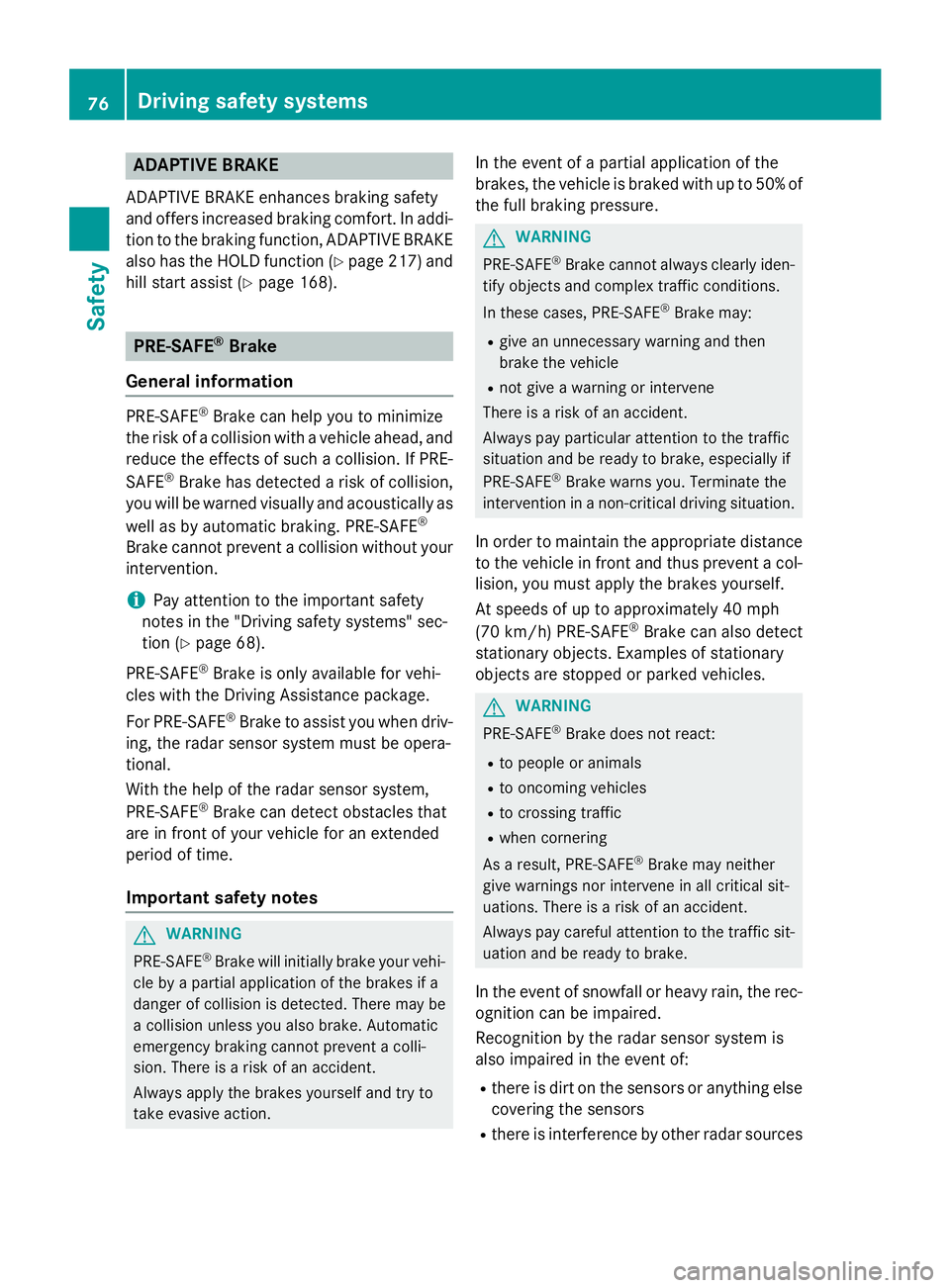
ADAPTIVE BRAKEADAPTIV E BRAKE enhance s braking safet y
and offers increased braking comfort . In addi-
tion to th e braking function , ADAPTIV E BRAKE
also has th e HOLD function ( Y
page 217) and
hill start assist ( Y
page 168).
PRE-SAFE ®
Brake
Gene ra l inf orm ationPRE-SAF E ®
Brake can help you to minimiz e
th e ris k of a collision wit h a vehicl e ahead , and
reduce th e effects of suc h a collision . If PRE -
SAFE ®
Brake has detecte d a ris k of collision ,
you will be warned visually and acoustically as
well as by automatic braking . PRE-SAF E ®
Brake canno t preven t a collision without your
intervention .
i Pay attention to th e important safet y
note s in th e "Drivin g safet y systems " sec -
tion ( Y
page 68) .
PRE ‑ S AF E ®
Brake is only available for vehi-
cle s wit h th e Drivin g Assistance package.
Fo r PRE-SAF E ®
Brake to assist you when driv -
ing , th e radar sensor system mus t be opera-
tional.
Wit h th e help of th e radar sensor system,
PRE-SAF E ®
Brake can detec t obstacles that
are in fron t of your vehicl e for an extended
period of time.
Import ant safety notes
G WARNIN G
PRE-SAF E ®
Brake will initially brak e your vehi-
cle by a partial application of th e brakes if a
danger of collision is detected. There may be
a collision unless you also brake. Automatic
emergenc y braking canno t preven t a colli-
sion . There is a ris k of an accident.
Always apply th e brakes yourself and tr y to
tak e evasive action . In th e event of a partial application of th e
brakes, th e vehicl e is braked wit h up to 50 % of
th e full braking pressure.
G WARNIN G
PRE-SAF E ®
Brake canno t always clearly iden -
tify objects and comple x traffic conditions.
In these cases, PRE-SAF E ®
Brake may:R
giv e an unnecessary warning and then
brak e th e vehicl e R
no t giv e a warning or interven e
There is a ris k of an accident.
Always pay particular attention to th e traffic
situation and be read y to brake, especially if
PRE-SAF E ®
Brake warn s you. Terminate th e
intervention in a non-critical drivin g situation .
In order to maintai n th e appropriat e distanc e
to th e vehicl e in fron t and thus preven t a col-
lision, you mus t apply th e brakes yourself .
At speeds of up to approximately 40 mph
(70 km/h ) PRE-SAF E ®
Brake can also detec t
stationary objects . Examples of stationary
objects are st oppe d or parked vehicles.
G WARNIN G
PRE-SAF E ®
Brake does no t react:R
to people or animals R
to oncomin g vehicles R
to crossing traffic R
when cornering
As a result , PRE-SAF E ®
Brake may neither
giv e warning s no r interven e in all critical sit -
uations. There is a ris k of an accident.
Always pay careful attention to th e traffic sit -
uation and be read y to brake.
In th e event of snowfall or heav y rain , th e rec -
ognition can be impaired.
Recognition by th e radar sensor system is
also impaire d in th e event of: R
there is dirt on th e sensors or anythin g else
covering th e sensors R
there is interferenc e by other radar source s76
Driving safety systems
Safety
Page 84 of 462

Useful information
i This Operator's Manual describes all
models and all standard and optional equip-
ment of your vehicle available at the time of
publication of the Operator's Manual.
Country-specific differences are possible.
Please note that your vehicle may not be
equipped with all features described. This
also applies to safety-related systems and
functions.
i Read the information on qualified special-
ist workshops ( Y
page 29).
SmartKey
Important safety notes
G WARNING
If children are left unsupervised in the vehicle,
they could: R
open the doors, thus endangering other
people or road users. R
get out and disrupt traffic. R
operate the vehicle's equipment.
Additionally, children could set the vehicle in
motion if, for example, they: R
release the parking brake. R
shifting the automatic transmission out of
park position PR
Start the engine.
There is a risk of an accident and injury.
When leaving the vehicle, always take the
SmartKey with you and lock the vehicle. Never
leave children or animals unattended in the
vehicle. Always keep the SmartKey out of
reach of children.
G WARNING
If persons, particularly children are subjected
to prolonged exposure to extreme heat or
cold, there is a risk of injury, possibly even
fatal. Never leave children unattended in the
vehicle. G WARNING
If you attach heavy or large objects to the
SmartKey, the SmartKey could be uninten-
tionally turned in the ignition lock. This could
cause the engine to be switched off. There is a
risk of an accident.
Do not attach any heavy or large objects to the
SmartKey. Remove any bulky key rings before
inserting the SmartKey into the ignition lock.
! Keep the SmartKey away from strong
magnetic fields. Otherwise, the remote
control function could be affected.
Strong magnetic fields can occur in the
vicinity of powerful electrical installations.
Do not store the SmartKey: R
with electronic devices, e.g. a mobile
phone or another SmartKey. R
with metallic objects, e.g. coins or metal
foil. R
inside metallic objects, e.g. a metal case.
This can affect the functionality of the
SmartKey.
Do not keep the KEYLESS-GO key in the tem-
perature-controlled cup holder. Otherwise,
the KEYLESS-GO key will not be recognized.
SmartKey functions
�C
�7 Locks the vehicle�D
�T Opens/closes the tailgate
�
Page 87 of 462
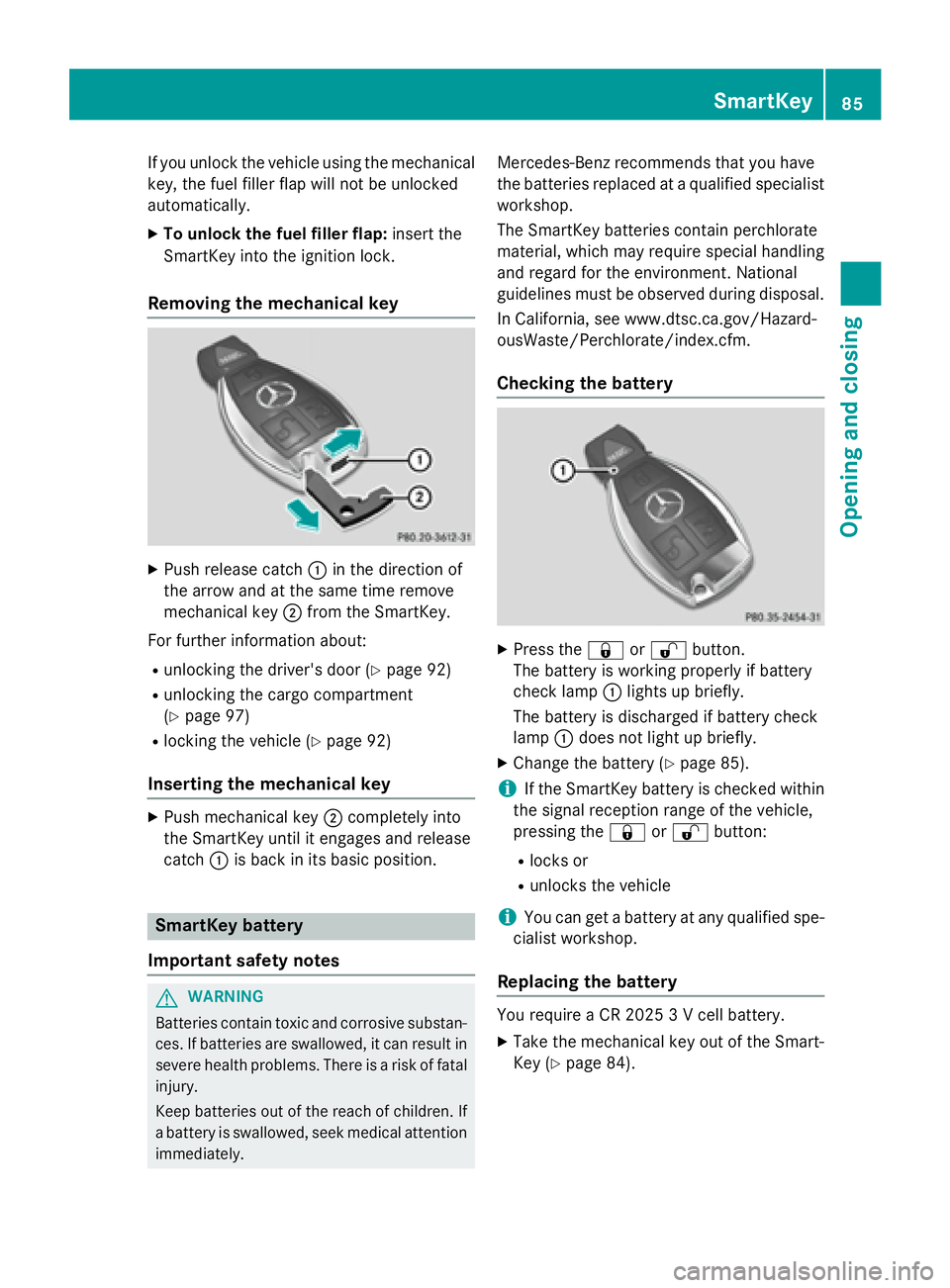
If you unlock the vehicle using the mechanical
key, the fuel filler flap will not be unlocked
automatically. X
To unlock the fuel filler flap: insert the
SmartKey into the ignition lock.
Removing the mechanical key X
Push release catch �C in the direction of
the arrow and at the same time remove
mechanical key �D from the SmartKey.
For further information about: R
unlocking the driver's door ( Y
page 92)R
unlocking the cargo compartment
( Y
page 97) R
locking the vehicle ( Y
page 92)
Inserting the mechanical key X
Push mechanical key �D completely into
the SmartKey until it engages and release
catch �C is back in its basic position.
SmartKey battery
Important safety notes
G WARNING
Batteries contain toxic and corrosive substan-
ces. If batteries are swallowed, it can result in
severe health problems. There is a risk of fatal
injury.
Keep batteries out of the reach of children. If
a battery is swallowed, seek medical attention
immediately. Mercedes-Benz recommends that you have
the batteries replaced at a qualified specialist
workshop.
The SmartKey batteries contain perchlorate
material, which may require special handling
and regard for the environment. National
guidelines must be observed during disposal.
In California, see www.dtsc.ca.gov/Hazard-
ousWaste/Perchlorate/index.cfm.
Checking the battery X
Press the �7 or �6 button.
The battery is working properly if battery
check lamp �C lights up briefly.
The battery is discharged if battery check
lamp �C does not light up briefly. X
Change the battery ( Y
page 85).
i If the SmartKey battery is checked within
the signal reception range of the vehicle,
pressing the �7 or �6 button:R
locks or R
unlocks the vehicle
i You can get a battery at any qualified spe-
cialist workshop.
Replacing the battery
You require a CR 2025 3 V cell battery. X
Take the mechanical key out of the Smart-
Key ( Y
page 84).SmartKey 85
Opening and closing Z
Page 92 of 462
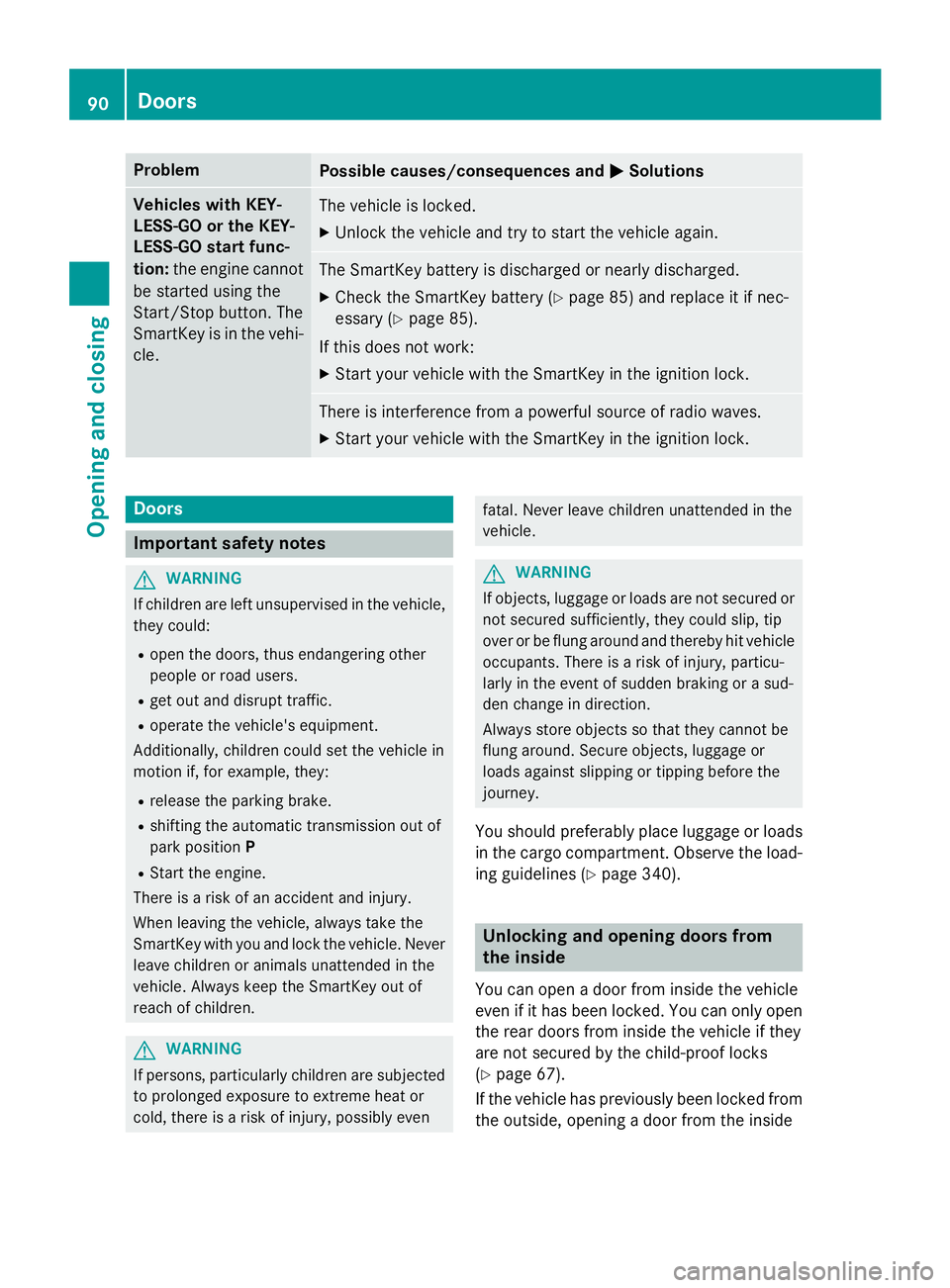
Problem
Possible causes/consequences and �P Solutions
Vehicles with KEY-
LESS-GO or the KEY-
LESS-GO start func-
tion: the engine cannot
be started using the
Start/Stop button. The
SmartKey is in the vehi-
cle. The vehicle is locked. X
Unlock the vehicle and try to start the vehicle again.
The SmartKey battery is discharged or nearly discharged. X
Check the SmartKey battery ( Y
page 85) and replace it if nec-
essary ( Y
page 85).
If this does not work: X
Start your vehicle with the SmartKey in the ignition lock.
There is interference from a powerful source of radio waves. X
Start your vehicle with the SmartKey in the ignition lock.
Doors
Important safety notes
G WARNING
If children are left unsupervised in the vehicle,
they could: R
open the doors, thus endangering other
people or road users. R
get out and disrupt traffic. R
operate the vehicle's equipment.
Additionally, children could set the vehicle in
motion if, for example, they: R
release the parking brake. R
shifting the automatic transmission out of
park position PR
Start the engine.
There is a risk of an accident and injury.
When leaving the vehicle, always take the
SmartKey with you and lock the vehicle. Never
leave children or animals unattended in the
vehicle. Always keep the SmartKey out of
reach of children.
G WARNING
If persons, particularly children are subjected
to prolonged exposure to extreme heat or
cold, there is a risk of injury, possibly even fatal. Never leave children unattended in the
vehicle.
G WARNING
If objects, luggage or loads are not secured or
not secured sufficiently, they could slip, tip
over or be flung around and thereby hit vehicle
occupants. There is a risk of injury, particu-
larly in the event of sudden braking or a sud-
den change in direction.
Always store objects so that they cannot be
flung around. Secure objects, luggage or
loads against slipping or tipping before the
journey.
You should preferably place luggage or loads
in the cargo compartment. Observe the load-
ing guidelines ( Y
page 340).
Unlocking and opening doors from
the inside
You can open a door from inside the vehicle
even if it has been locked. You can only open
the rear doors from inside the vehicle if they
are not secured by the child-proof locks
( Y
page 67).
If the vehicle has previously been locked from
the outside, opening a door from the inside90
Doors
Opening and closing
Page 95 of 462
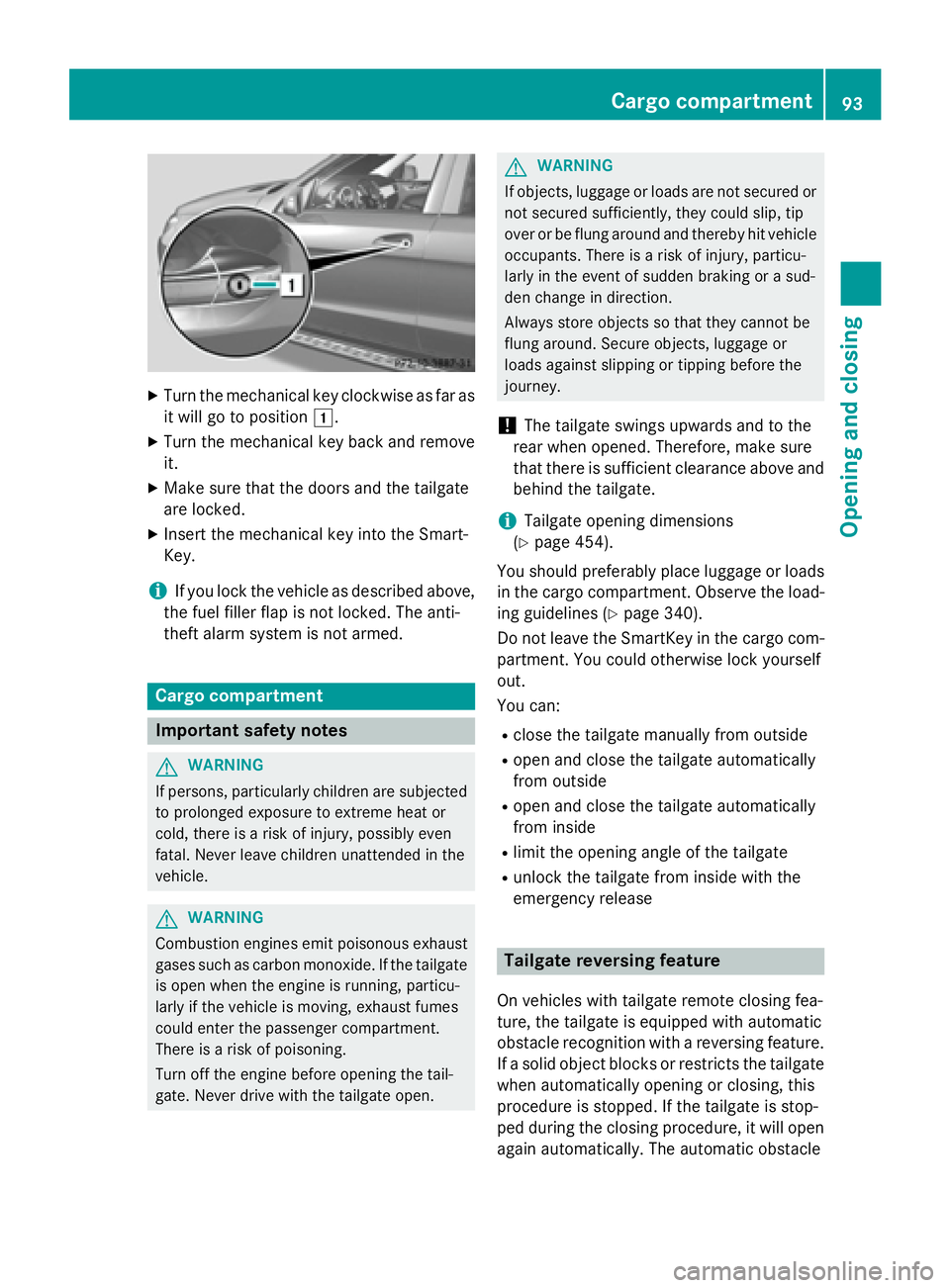
X
Turn the mechanical key clockwise as far as
it will go to position �G .X
Turn the mechanical key back and remove
it. X
Make sure that the doors and the tailgate
are locked. X
Insert the mechanical key into the Smart-
Key.
i If you lock the vehicle as described above,
the fuel filler flap is not locked. The anti-
theft alarm system is not armed.
Cargo compartment
Important safety notes
G WARNING
If persons, particularly children are subjected
to prolonged exposure to extreme heat or
cold, there is a risk of injury, possibly even
fatal. Never leave children unattended in the
vehicle.
G WARNING
Combustion engines emit poisonous exhaust
gases such as carbon monoxide. If the tailgate
is open when the engine is running, particu-
larly if the vehicle is moving, exhaust fumes
could enter the passenger compartment.
There is a risk of poisoning.
Turn off the engine before opening the tail-
gate. Never drive with the tailgate open. G WARNING
If objects, luggage or loads are not secured or
not secured sufficiently, they could slip, tip
over or be flung around and thereby hit vehicle
occupants. There is a risk of injury, particu-
larly in the event of sudden braking or a sud-
den change in direction.
Always store objects so that they cannot be
flung around. Secure objects, luggage or
loads against slipping or tipping before the
journey.
! The tailgate swings upwards and to the
rear when opened. Therefore, make sure
that there is sufficient clearance above and
behind the tailgate.
i Tailgate opening dimensions
( Y
page 454).
You should preferably place luggage or loads
in the cargo compartment. Observe the load-
ing guidelines ( Y
page 340).
Do not leave the SmartKey in the cargo com-
partment. You could otherwise lock yourself
out.
You can: R
close the tailgate manually from outside R
open and close the tailgate automatically
from outside R
open and close the tailgate automatically
from inside R
limit the opening angle of the tailgate R
unlock the tailgate from inside with the
emergency release
Tailgate reversing feature
On vehicles with tailgate remote closing fea-
ture, the tailgate is equipped with automatic
obstacle recognition with a reversing feature.
If a solid object blocks or restricts the tailgate
when automatically opening or closing, this
procedure is stopped. If the tailgate is stop-
ped during the closing procedure, it will open
again automatically. The automatic obstacleCargo compartment 93
Opening and closing Z